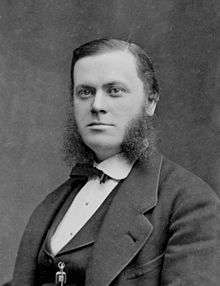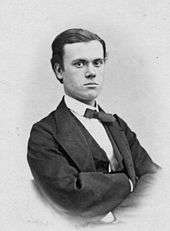Per Teodor Cleve
| Per Teodor Cleve | |
|---|---|
 Per Teodor Cleve, c. 1880–1890 | |
| Born |
10 February 1840 Stockholm, Sweden |
| Died |
18 June 1905 (aged 65) Uppsala, Sweden |
| Nationality | Swedish |
| Fields | Chemistry, geology |
| Alma mater |
Stockholm Gymnasium (1858) Uppsala University (1863) |
| Known for | Discovery of holmium and thulium |
| Notable awards | Davy Medal (1894) |
Per Teodor Cleve (10 February 1840 – 18 June 1905) was a Swedish chemist, biologist, mineralogist, oceanographer, and professor.[1][2] He discovered the chemical elements holmium and thulium and helped isolate helium from the uranium ore cleveite.[1] Cleve was born in Stockholm and became an assistant professor at the Uppsala University in 1860. He died several months after contracting pleurisy in 1904.
Early life

Cleve was born in Stockholm, Sweden, as the thirteenth child of his father,[1][3] a merchant known as F. T. Cleve.[3][4] Cleve's ancestors on his father's side came from western Germany and settled in Sweden in the late 18th century.[4]
Cleve showed interest in natural science and natural history from an early age.[4] He attended the Stockholm Gymnasium in 1858, studying chemistry and biology.[2][3] He gained a Bachelor of Science degree from the University of Uppsala in 1863 and a PhD from the same university in 1868.[3]
Career
In 1860, aged 20, Cleve became assistant professor of mineralogy at the University of Uppsala,[5] and was appointed assistant professor of chemistry in 1868.[1][5] He also taught at the Royal Institute of Technology between 1870 and 1874, and eventually became professor of general and agricultural chemistry at the University of Uppsala.[1] He was the chair of chemistry at the University of Uppsala starting in 1874. He was also the president of the Nobel Committee for Chemistry.[6]
Cleve's first work was Några ammoniakaliska chromföreningar (Some compounds of ammonia and chromium, 1861).[2][5] He also wrote several more papers on complex compounds, including the compounds of platinum.[2][5] Additionally, Cleve synthesized several hundred complex platinum compounds.[5]
Cleve visited a number of laboratories in England, France, Italy, and Switzerland in the 1860s.[5] While in Paris, he visited the laboratory of Charles-Adolphe Wurtz and also made a number of friends there.[5]

Cleve worked on the synthesis of complex chemical compounds until 1872.[2] He theorized in 1874 that the element didymium consisted of two elements. This theory was proven right with the discovery of praseodymium and neodymium in 1885 by Carl Auer von Welsbach. In 1879, Cleve proved that the newly discovered element scandium was an element predicted by Dmitri Mendeleev to be "eka-boron".[1] He isolated a quantity of scandium in this same year and determined its atomic weight.[2] He discovered the element holmium in 1879 by examining a sample of erbium oxide.[7] While removing impurities from a sample of erbium oxide, Cleve discovered a brown substance and a green substance, and the brown substance was holmium oxide (the green substance was thulium oxide).[7][8] However, this sample may have been impure.[9] He separated thulium from an erbium oxide sample in 1879.[10] Additionally, Cleve and Abraham Langlet discovered helium in the mineral cleveite in 1895.[11]
Cleve discovered six forms of dichloronaphthalene and discovered aminonaphthalenesulfonic acids, which are sometimes named after him.[1] He prepared a number of nitrosulfonic acids as well.[4] In 1883, Cleve was the first person to describe the plankton species Nitzschia seriata.[3] In 1890, Cleve began to mainly focus on the field of biology, mainly studying freshwater algae, diatoms, and plankton.[1] Cleve participated in a Swedish expedition to Spitsbergen in 1898. While on this mission, he discovered a number of species of spumellarians, nassellarians, and phaeodarians.[12]
Cleve, in collaboration with Höglund prepared numerous previously-undiscovered salts of yttrium and erbium. The two also did work on the chemistry of the chemical elements thorium and lanthanum. By 1874, Cleve discovered that thorium was a quadrivalent element and also determined lanthanum to be trivalent. These findings were initially doubted by the scientific community.[4]
Cleve was the first observer of isomerism in platinumamine derivatives.[6]
Additionally, Cleve created a method of dating glacial and post-glacial deposits in the fossil record.[3]
Cleve's PhD dissertation was "Mineral-analytiska under-sökningar". He wrote a paper on samarium in 1879 and The Seasonal Distribution of Atlantic Plankton Organisms in 1900.[1][2] In 1883, he published Kemiskt Handlexicon, which translates to Chemical Handbook. Notable students of Cleve include Ellen Fries (the first Swedish woman to earn a PhD) and Svante Arrhenius (a winner of the Nobel Prize).[3]
Cleve also studied hydrography and geology.[3]
Personal life, family, and death
In 1874, Cleve married Alma Öhbom, a teacher;[3] the couple had three daughters. The first daughter, Astrid Cleve (born 22 January 1875), became a botanist.[3][13] His son-in-law and grandson, Hans von Euler-Chelpin and Ulf von Euler, both won Nobel Prizes.[3] Cleve was friends with Thomas Edward Thorpe.[4]
Cleve was a supporter of women's equality.[3]
Cleve began experiencing pleurisy in December 1904 and it affected his heart. He recovered by the spring of 1905 and returned to Uppsala, Sweden,.[4] where he died on 18 June 1905.[1]
Awards and legacy
Cleve joined the Royal Swedish Academy of Sciences in 1871. He received a Davy Medal in 1894 and 1904.[3][6]
The mineral cleveite is named for Cleve.[3]
References
- 1 2 3 4 5 6 7 8 9 10 "Per Teodor Cleve". Encyclopædia Britannica. Retrieved 13 March 2014.
- 1 2 3 4 5 6 7 Charles Scribner's Sons (2008), "Cleve, Per Teodor", encyclopedia.com, retrieved 13 March 2014
- 1 2 3 4 5 6 7 8 9 10 11 12 13 14 Per Theodor Cleve, retrieved 13 March 2014
- 1 2 3 4 5 6 7 Chemical Society (Great Britain), Sir Humphry Davy, Bureau of Chemical Abstracts (Great Britain) (21 June 1906), The collected works of Sir Humphry Davy ...: Discourses delivered before the Royal society. Elements of agricultural chemistry, pt. I, Smith, Elder and Company
- 1 2 3 4 5 6 7 Ole Bostrup (2004), "Cleve, Per Theodor", encyclopedia.com, retrieved 14 March 2014
- 1 2 3 Ira Remsen; Charles August Rouillu, eds. (1905), American Chemical Journal, Volume 34
- 1 2 Doug Stewart, "Holmium Element Facts / Chemistry", chemicool.com, retrieved 14 March 2014
- ↑ Bradley Brooks, "Introduction to Holmium", Penetanguishene Secondary School, retrieved 14 March 2014
- ↑ John Emsley (2011), Nature's Building Blocks An A-Z Guide to the Elements New Edition, Oxford University Press, pp. 224, 225, ISBN 0199605637
- ↑ John Emsley (2011), Nature's Building Blocks An A-Z Guide to the Elements New Edition, Oxford University Press, p. 549, ISBN 0199605637
- ↑ Giora Shaviv (2009), Life of Stars: The Controversial Inception and Emergence of the Theory of Stellar Structure, Springer, ISBN 9783642020889
- ↑ Kjell R. Bjørklund; Takuya Itaki; Jane K. Dolven (2014), "Per Theodor Cleve: a short résumé and his radiolarian results from the Swedish Expedition to Spitsbergen in 1898", Journal of Micropalaeontology, 33: 59–93, doi:10.1144/jmpaleo2012-024
- ↑ Mary R. S. Creese; Thomas M. Creese (2004), Ladies in the Laboratory 2, Scarecrow Press, ISBN 0810849798
External links
| Wikimedia Commons has media related to Per Teodor Cleve. |
- Works by Per Teodor Cleve at Project Gutenberg
- Works by or about Per Teodor Cleve at Internet Archive